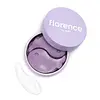What's inside
What's inside
 Key Ingredients
Key Ingredients

 Benefits
Benefits

 Concerns
Concerns

 Ingredients Side-by-side
Ingredients Side-by-side

Water
Skin ConditioningGlyceryl Stearate Se
EmulsifyingC15-19 Alkane
SolventGlycerin
HumectantHydrogenated Farnesene
EmollientStearyl Alcohol
EmollientPrunus Armeniaca Kernel Oil
MaskingSesamum Indicum Seed Oil
EmollientNonapeptide-1
Skin ConditioningPalmitoyl Tripeptide-5
Skin ConditioningSodium Hyaluronate
HumectantCoffea Arabica Seed Oil
MaskingCaffeine
Skin ConditioningButyrospermum Parkii Butter
Skin ConditioningPanthenol
Skin ConditioningTremella Fuciformis Extract
HumectantDunaliella Salina Extract
Skin ConditioningCetyl Alcohol
EmollientGlyceryl Behenate
EmollientSodium Stearate
CleansingSynthetic Fluorphlogopite
Propanediol
SolventCaprylyl Glycol
EmollientHexylene Glycol
EmulsifyingTocopheryl Acetate
AntioxidantGluconolactone
Skin ConditioningSodium Benzoate
MaskingSodium Phosphate
BufferingCitric Acid
BufferingEthylhexylglycerin
Skin ConditioningPantolactone
HumectantPhenoxyethanol
PreservativeTin Oxide
AbrasiveCalcium Gluconate
HumectantPotassium Sorbate
PreservativeDisodium Phosphate
BufferingCI 77891
Cosmetic ColorantWater, Glyceryl Stearate Se, C15-19 Alkane, Glycerin, Hydrogenated Farnesene, Stearyl Alcohol, Prunus Armeniaca Kernel Oil, Sesamum Indicum Seed Oil, Nonapeptide-1, Palmitoyl Tripeptide-5, Sodium Hyaluronate, Coffea Arabica Seed Oil, Caffeine, Butyrospermum Parkii Butter, Panthenol, Tremella Fuciformis Extract, Dunaliella Salina Extract, Cetyl Alcohol, Glyceryl Behenate, Sodium Stearate, Synthetic Fluorphlogopite, Propanediol, Caprylyl Glycol, Hexylene Glycol, Tocopheryl Acetate, Gluconolactone, Sodium Benzoate, Sodium Phosphate, Citric Acid, Ethylhexylglycerin, Pantolactone, Phenoxyethanol, Tin Oxide, Calcium Gluconate, Potassium Sorbate, Disodium Phosphate, CI 77891
Water
Skin ConditioningGlycerin
HumectantNiacinamide
SmoothingCarrageenan
Butylene Glycol
HumectantSodium Hyaluronate
HumectantArginine
MaskingDextrin
AbsorbentAllantoin
Skin ConditioningCocos Nucifera Fruit Extract
EmollientDipotassium Glycyrrhizate
HumectantSucrose
HumectantPinus Sylvestris Leaf Extract
TonicCeratonia Siliqua Gum
EmollientPropanediol
SolventCyclodextrin
AbsorbentCyamopsis Tetragonoloba Gum
Emulsion StabilisingRicinus Communis Seed Oil
MaskingHydroxyacetophenone
AntioxidantPentylene Glycol
Skin ConditioningPolyglyceryl-10 Laurate
Skin ConditioningHexylene Glycol
EmulsifyingCalcium Chloride
AstringentCellulose Gum
Emulsion Stabilising1,2-Hexanediol
Skin ConditioningPolymethylsilsesquioxane
Silica
AbrasivePolyglyceryl-10 Oleate
Skin ConditioningEthylhexylglycerin
Skin ConditioningChlorphenesin
AntimicrobialDisodium EDTA
Synthetic Fluorphlogopite
CI 77491
Cosmetic ColorantCI 77891
Cosmetic ColorantCI 77007
Cosmetic ColorantWater, Glycerin, Niacinamide, Carrageenan, Butylene Glycol, Sodium Hyaluronate, Arginine, Dextrin, Allantoin, Cocos Nucifera Fruit Extract, Dipotassium Glycyrrhizate, Sucrose, Pinus Sylvestris Leaf Extract, Ceratonia Siliqua Gum, Propanediol, Cyclodextrin, Cyamopsis Tetragonoloba Gum, Ricinus Communis Seed Oil, Hydroxyacetophenone, Pentylene Glycol, Polyglyceryl-10 Laurate, Hexylene Glycol, Calcium Chloride, Cellulose Gum, 1,2-Hexanediol, Polymethylsilsesquioxane, Silica, Polyglyceryl-10 Oleate, Ethylhexylglycerin, Chlorphenesin, Disodium EDTA, Synthetic Fluorphlogopite, CI 77491, CI 77891, CI 77007
Ingredients Explained
These ingredients are found in both products.
Ingredients higher up in an ingredient list are typically present in a larger amount.
Ci 77891 is a white pigment from Titanium dioxide. It is naturally found in minerals such as rutile and ilmenite.
It's main function is to add a white color to cosmetics. It can also be mixed with other colors to create different shades.
Ci 77891 is commonly found in sunscreens due to its ability to block UV rays.
Learn more about CI 77891Ethylhexylglycerin (we can't pronounce this either) is commonly used as a preservative and skin softener. It is derived from glyceryl.
You might see Ethylhexylglycerin often paired with other preservatives such as phenoxyethanol. Ethylhexylglycerin has been found to increase the effectiveness of these other preservatives.
Glycerin is already naturally found in your skin. It helps moisturize and protect your skin.
A study from 2016 found glycerin to be more effective as a humectant than AHAs and hyaluronic acid.
As a humectant, it helps the skin stay hydrated by pulling moisture to your skin. The low molecular weight of glycerin allows it to pull moisture into the deeper layers of your skin.
Hydrated skin improves your skin barrier; Your skin barrier helps protect against irritants and bacteria.
Glycerin has also been found to have antimicrobial and antiviral properties. Due to these properties, glycerin is often used in wound and burn treatments.
In cosmetics, glycerin is usually derived from plants such as soybean or palm. However, it can also be sourced from animals, such as tallow or animal fat.
This ingredient is organic, colorless, odorless, and non-toxic.
Glycerin is the name for this ingredient in American English. British English uses Glycerol/Glycerine.
Learn more about GlycerinHexylene Glycol is a surfactant. Glycols are a class of alcohols. Hexylene Glycol is a surfactant and emulsifier.
As a surfactant, Hexylene Glycol helps gather dirt and oil on your skin to be washed away.
As an emulsifier, Hexylene Glycol helps keep water and oil together. This prevents them from separating in a product. Hexylene Glycol also thins out the texture of a product by lessening viscosity.
Hexylene Glycol has a small molecular weight.
Learn more about Hexylene GlycolPropanediol is an all-star ingredient. It softens, hydrates, and smooths the skin.
It’s often used to:
Propanediol is not likely to cause sensitivity and considered safe to use. It is derived from corn or petroleum with a clear color and no scent.
Learn more about PropanediolSodium Hyaluronate is hyaluronic acid's salt form. It is commonly derived from the sodium salt of hyaluronic acid.
Like hyaluronic acid, it is great at holding water and acts as a humectant. This makes it a great skin hydrating ingredient.
Sodium Hyaluronate is naturally occurring in our bodies and is mostly found in eye fluid and joints.
These are some other common types of Hyaluronic Acid:
Learn more about Sodium HyaluronateSynthetic Fluorphlogopite is the synthethic version of mica. It consists of fluorine, aluminum and silicate.
Synthetic Fluorphlogopite is used to add volume to products.
It is considered non-irritating on the skin.
Learn more about Synthetic FluorphlogopiteWater. It's the most common cosmetic ingredient of all. You'll usually see it at the top of ingredient lists, meaning that it makes up the largest part of the product.
So why is it so popular? Water most often acts as a solvent - this means that it helps dissolve other ingredients into the formulation.
You'll also recognize water as that liquid we all need to stay alive. If you see this, drink a glass of water. Stay hydrated!
Learn more about Water